15 minutes to read
Best 8 bug tracking tools in 2025 by DeviQA’s engineers


Ievgen Ievdokymov
Senior QA Engineer
More than 50% of users would fully quit the app if they came across one or more bugs during a single day of app usage.
Yes, bugs are an inevitable part of software development, but how you handle them can make or break your product.
Without an organized bug tracking system, critical bugs can go unnoticed, leading to poor user experience and financial losses. Like a well-known Amazon bug, when in the run-up to Christmas, the cost of some goods on the Amazon site dropped to one cent because of a single software glitch.
With Amazon’s automatic delivery and services on warehousing, plenty of orders have already been shipped before sellers could cancel them. As a result – several businesses suffered losses of about $170,000 each and were on the verge of bankruptcy.
Why do you need bug tracking tools aka bug trackers?
A bug-tracking tool organizes the software testing process with reporting, prioritizing, and documenting fixing bugs. Basically it acts as a central hub where a dedicated QA team can document issues, assign tasks, and monitor progress until resolution.
Why does your team need a bug tracker? The answer lies in complexity and scale.
Consortium for IT Software Quality (CISQ) found that software defects cost the U.S. economy $2.41 trillion annually due to operational failures and rework.
And going further without a bug-tracking tool, identifying the root cause of issues becomes a guessing game, delays pile up, and customer satisfaction plummets.
Bugs belong in nature, not in your software.
Issue tracking software vs bug tracking software
While the terms are often used interchangeably, there’s a subtle distinction. Bug tracking software focuses specifically on software defects – think crashes, glitches, or unexpected behaviors.
Issue tracking software, however, casts a wider net, encompassing bugs alongside feature requests, tasks, or customer support tickets. For example, Jira excels as both, while Bugzilla hones in on bug-specific workflows. DeviQA quality assurance services leverage these tools to tailor solutions, ensuring businesses address both bugs and broader issues effectively.
Benefits of bug tracking tools
Far more than a checklist, bug-tracking tools empower QA teams with structure, insight, and efficiency – cornerstones of best-in-class quality assurance
From sharpening collaboration to slashing costs, these tools deliver advantages for software testing services processes. Here’s what they bring to the table.
Improved communication
A centralized bug tracking system ensures seamless communication across teams with a single source of truth – the Atlassian report revealed that teams using Jira saw a 30% boost in collaboration efficiency.
Developers, testers, and stakeholders can collaborate in real time, reducing misunderstandings and improving problem resolution speed. With real-time updates, comment threads, and notifications, that bridges the communications gap, everyone stays aligned.
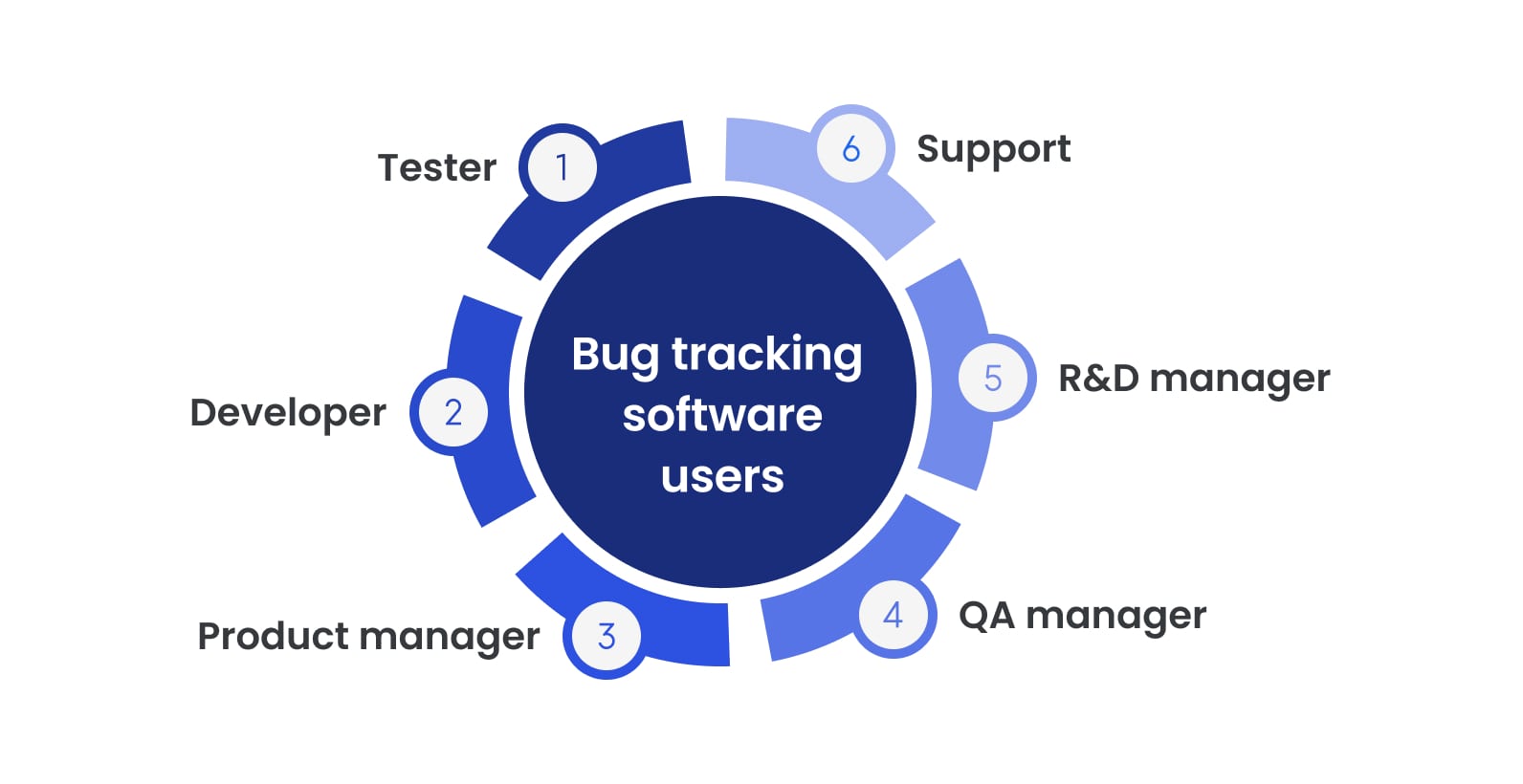
Lowering development expenses
Bug tracking tools can easily turn a potential $10,000 post-release nightmare into a $100 tweak during coding, especially with professional QA as a Service. When you save – you earn, that’s just business.
Fixing bugs in later stages of development can cost up to 100% more than addressing them during early phases. A structured bug tracking tool helps detect and resolve defects early, saving both time and money.
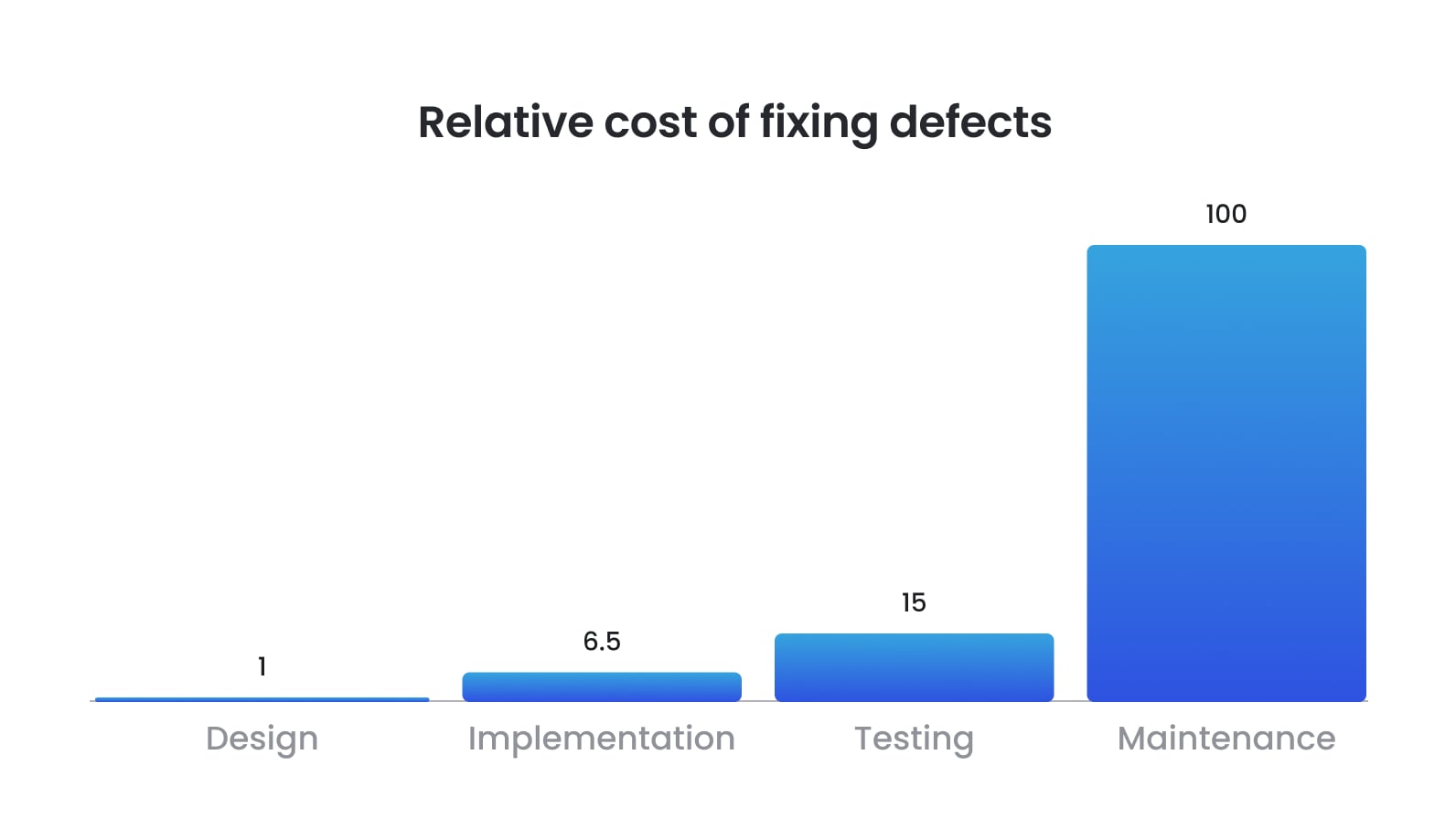
Bug tracking tools can fit every budget. Open-source solutions like Redmine deliver robust features at no licensing cost, while premium solutions like monday dev cater to enterprise needs.
Companies adopting bug-tracking tools saw development costs drop by 15-25% within a year – the ROI is clear.
Increased accountability
Who’s handling that pesky bug? With clear ownership of reported bugs, teams can track progress efficiently. This transparency boosts accountability, ensuring tasks don’t languish unresolved. Studies show teams with clear accountability frameworks – like those enabled by tools such as Redmine – improve project completion rates by 25%.
Activity tracking
It's essential to know the scope of the tasks finished by a specific team member. Most of the bug tracking tools have activity sections for each team member where you can see all of the tasks completed by the colleague over a while.
Also, some bug tracking tools support direct hour tracking for each task, and developers can add hours spent for each finished task. It could be handy if you want to know the amount of work that can be finished by a specific developer for one day.
Planning tools
When the development process goes at full speed, and all team members have tasks for a few weeks in advance, it is essential to continue building plans for the future. But rather than store those plans in text files or elsewhere, it's better to useBacklog storage.
It's an unlimited cloud folder where you can sort your tasks by different parameters. If you have several projects, it's easy to split future tasks by specific projects or by various categories.
Agile development methodologies support
If you are planning to use agile methodology in your project development, then bug-tracking software is the best tool for you. Most have all the necessary tools for full agile methodology implementation.
Scrum boards, kanban boards, sprint backlogs, story points assignments, and a lot more. All the required attributes of agile methodologies are available by default; all you need to do is just customize those for the needs of your project.
Reports and statistics
Every good bug tracking software has a system of reports.
From time to time, you need to check the progress of teamwork and tasks status. Some bug tracking tools have built-in tools for those needs, and some offer plugins with Burndown Charts and all sorts of different graphs about types of issues, lists of uncompleted tasks in the project, etc.
Bug tracking scenario example
Imagine a QA team discovers a critical security vulnerability in a new software release. Without a bug tracker, the issue could get lost in communication, delaying resolution. With bug tracking software, the process is efficient and controlled:
Top bug tracking software in 2025
Choosing the right bug tracking software can make or break your QA strategy. Here’s a rundown of the most popular bug tracking tools to suit businesses of all sizes.
Best open-source bug tracking tools
For companies prioritizing flexibility and cost management, open-source bug tracking software offers a compelling solution. Here is the list of the best tools open-source bug tracking tools that
provide high standards of quality assurance without the overhead of licensing fees.
Mantis
MantisBT, launched in 2000, is an open-source tool balancing simplicity and functionality. Built on PHP and supports Linux, Windows and macOS on the server side. Compatible with Chrome, Firefox, Safari, Opera and Edge. Available in 49 languages, it’s widely used for its customizable workflows and email notifications, on issue updates, resolution, or comments, serving both small teams and larger engineering groups.
You can start with one or more of the demo options available or just go directly to the Mantis download page and get the latest version along with the guide to set up your own servers.
To install Mantis, you need your own web server or hosting purchase. You can use a simple computer as a web server (Mantis is not demanding on PC resources), but if you do not have time to configure the server, the issue can be solved by purchasing an account from a hosting company. You can also use the free 30-day trial hosting account from the Mantis developer.
Pricing: Free as an open-source tool; hosted options via MantisHub start at $35.95/month for basic plans, scaling to $74.95/month for Platinum features.
Mantis key features:
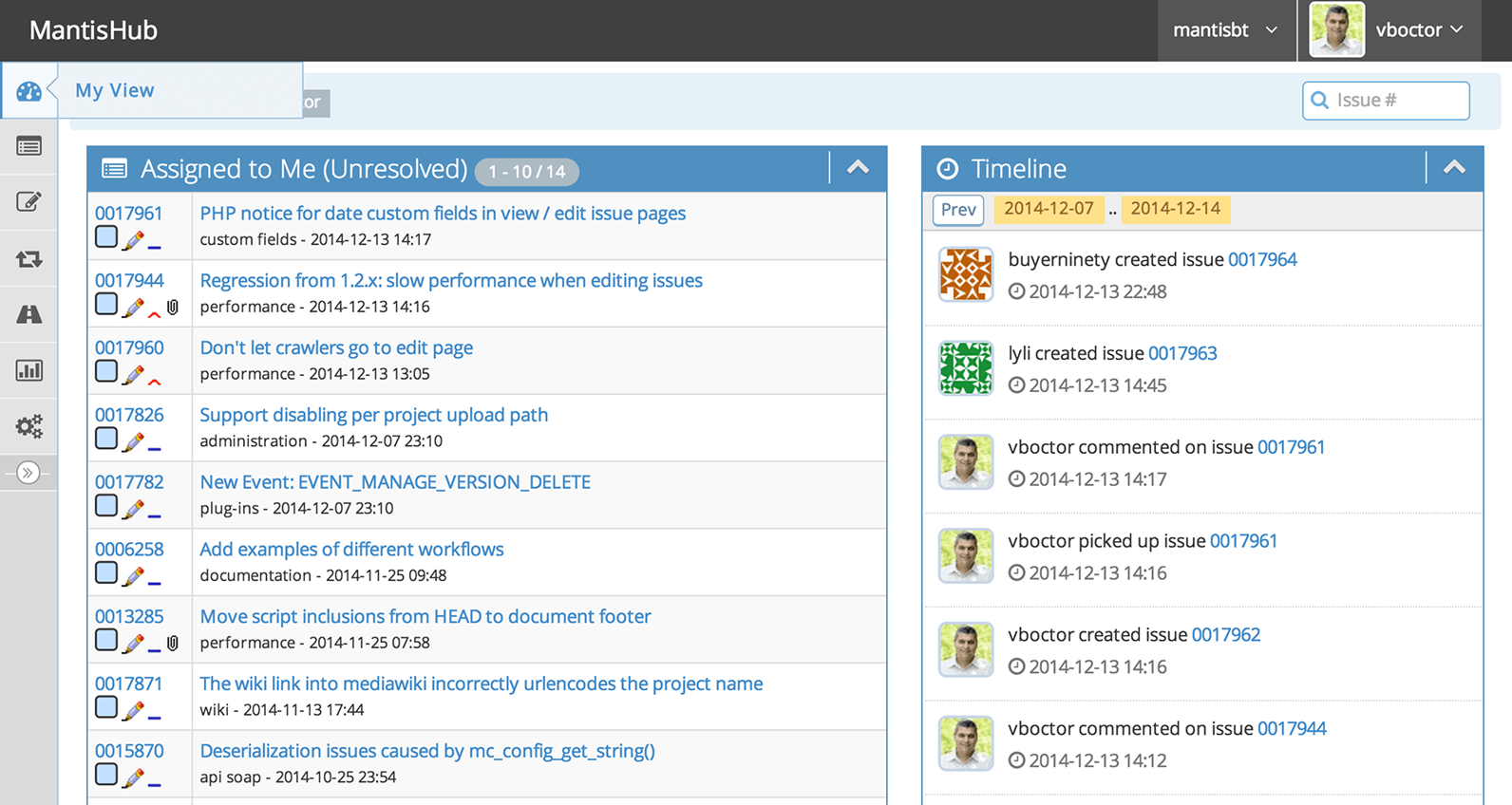
Redmine
Redmine, another open-source gem, is built and maintained by community volunteers and excels in multi-project management. Its integration with version control systems and features like Gantt charts make it a favorite, with Wikipedia notably fixing over 50,000 bugs using it in 2022. Once you register, you can create your own project there and try out the project administration features.
Pricing: Free for self-hosted use; managed hosting from providers like Planio starts at €19/month for 5 users, with higher tiers based on user count and storage.
Redmine key features:
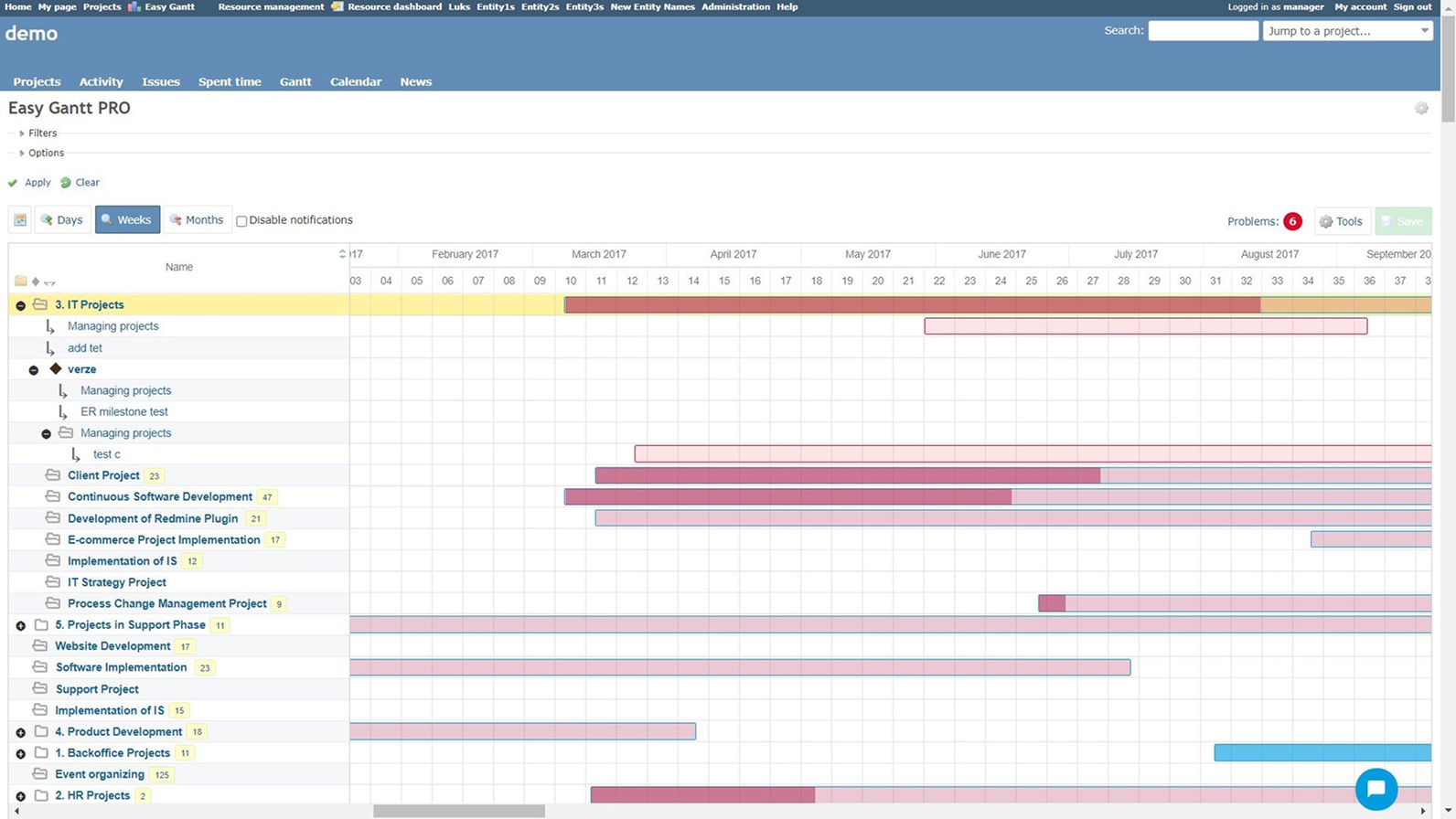
OTRS
OTRS (Open Ticket Request System) is an open-source ticketing system with bug tracking capabilities that offers ready-to-use solutions as well as customizable software for all service management needs. With over 80,000 users, including NASA (OTRS, 2023), it’s geared toward customer support and issue management, offering a broad, flexible platform. OTRS software solutions are the perfect choice for companies of any size.
Pricing: Free Community Edition available (self-hosted); commercial OTRS plans are custom priced with enterprise options scaling by agent and feature needs.
OTRS key features:
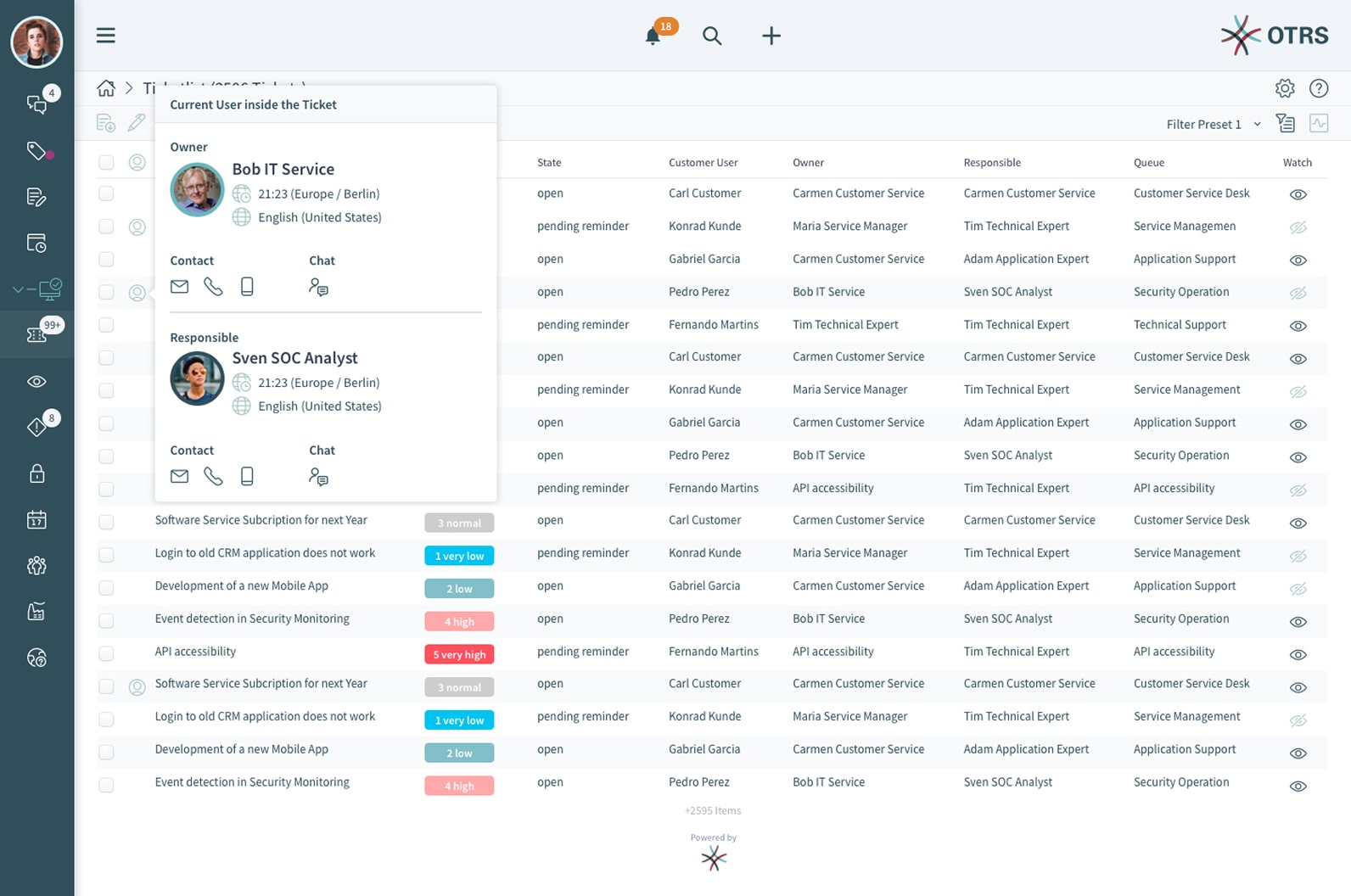
List of bug tracking software for enterprise
Jira
Jira, developed by Atlassian, is a powerhouse for bug and issue tracking, offering customizable workflows, Agile support, and extensive integrations. It’s favored by over 65,000 companies for its scalability and detailed reporting, making it ideal for complex, enterprise-level projects. The components of tasks can be expanded with additional fields or limited by settings; the workflow determines this. All changes to the task are logged. JIRA has a powerful Confluence extension for documentation purposes. Confluence lets you store any additional information related to your project.
Pricing: Free for up to 10 users; paid plans start at $$7.53 per user/month (Standard) and scale to $13.53 per user/month (Premium), with custom enterprise pricing available for larger teams.
JIRA key features:

Bugzilla
Bugzilla, an independently funded veteran open-source tool since 1998, excels in detailed defect management. Used by major players like Mozilla, Linux and LibreOffice, it’s perfect for technical teams needing precise bug tracking with advanced search and reporting capabilities, though it requires more setup effort.
Pricing: Free as an open-source tool; costs arise from optional premium support from third-party providers.
Bugzilla key features:
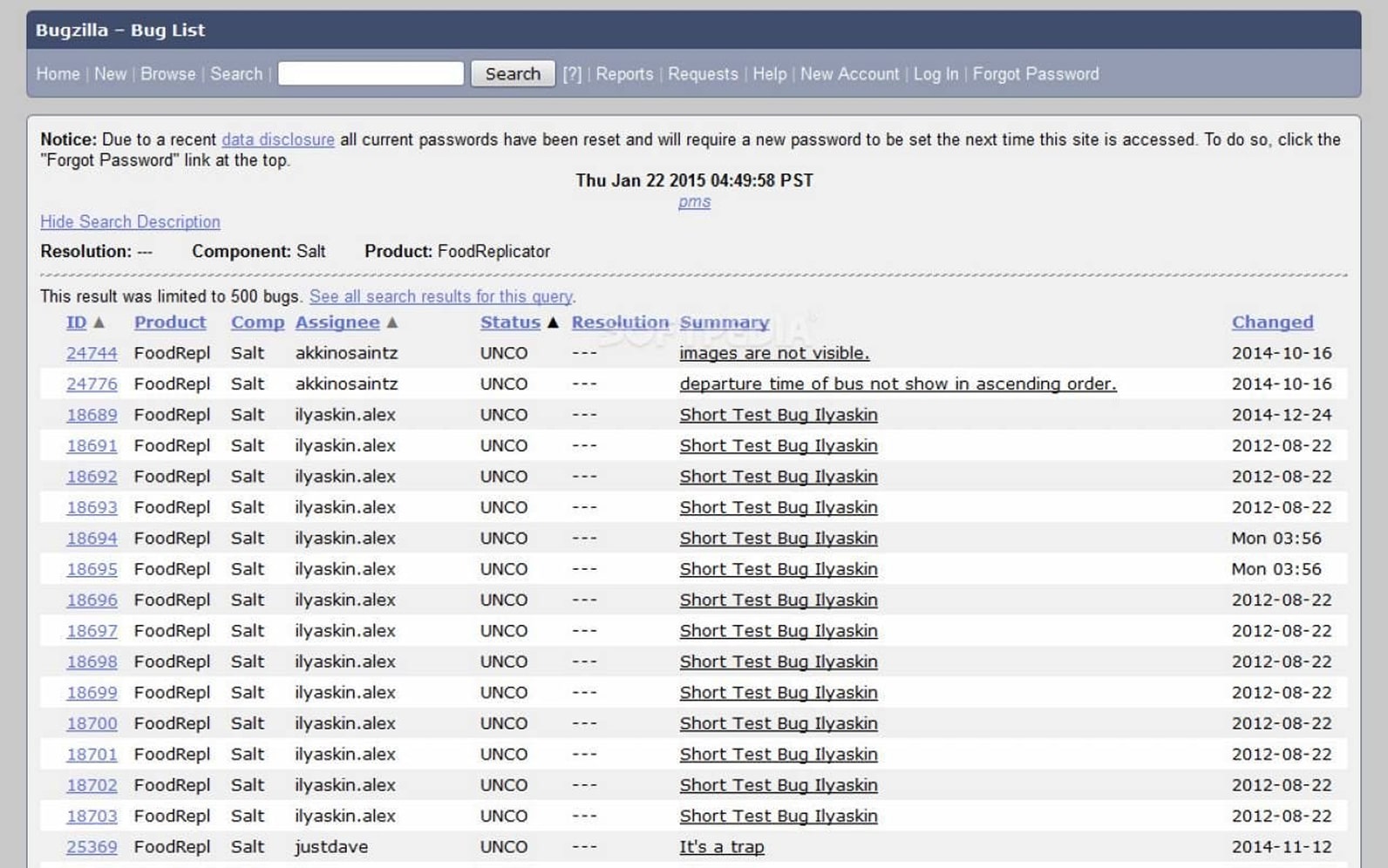
monday dev
Monday dev is a part of the monday.com ecosystem, providing a visual, flexible bug tracker tailored for development teams.
Its enterprise-grade features, like centralized issue tracking and workflow customization, make it a strong choice for teams managing large-scale projects.
Pricing: Built into monday.com plans – starts at $9 per seat/month (Basic, minimum 3 users), with Pro at $20 per seat/month and Enterprise offering custom quotes for advanced needs.
monday dev key features:
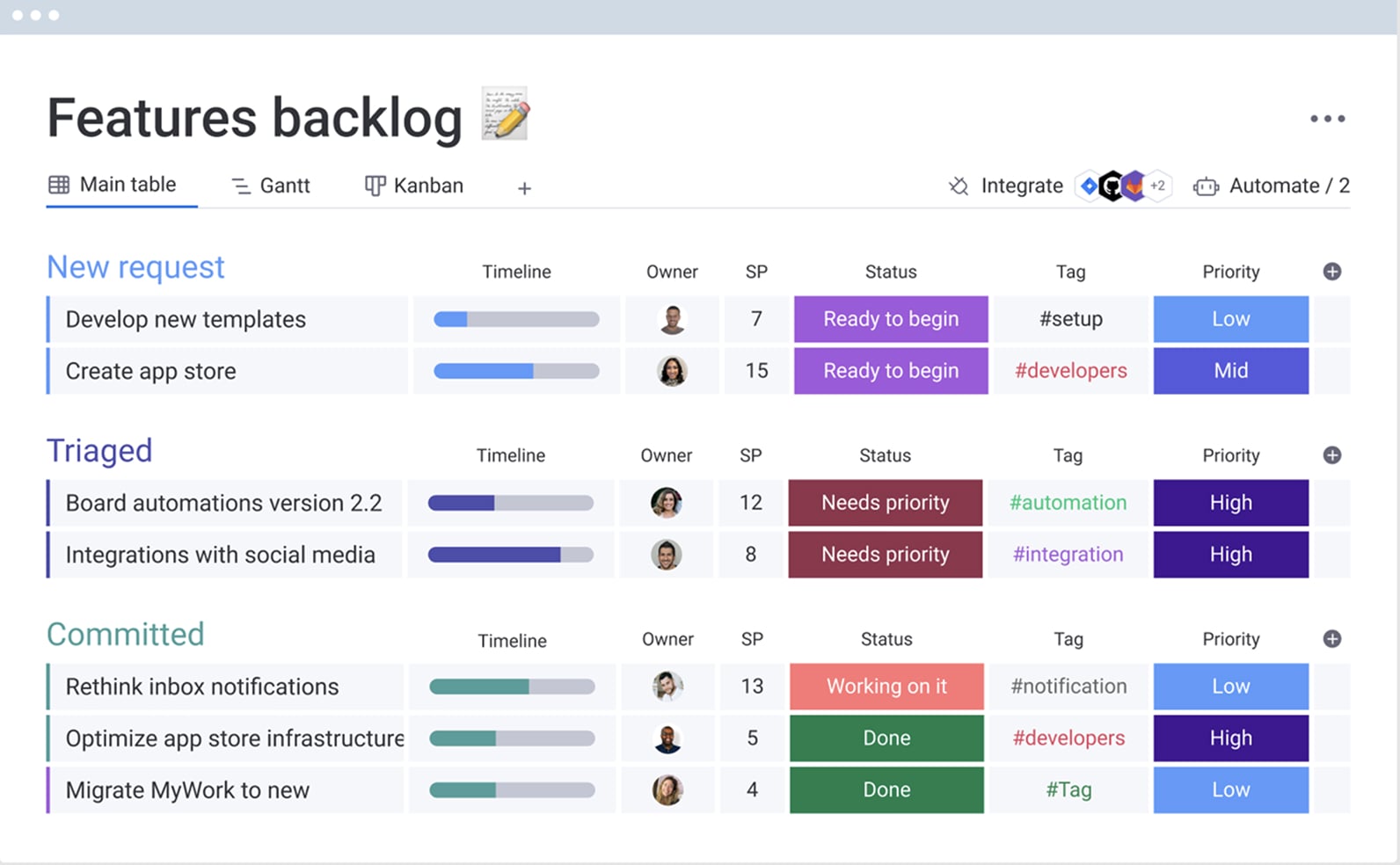
Top visual bug tracking software
Let’s explore the best visual bug tracking software that transforms the development process and why it’s a game-changer for businesses aiming for excellence.
Trello
Trello, also developed by Atlassian, uses a card-based kanban-style system for bug tracking, leveraging visual boards to simplify task management. With 2 million teams globally, it’s a go-to for startups and small groups seeking an intuitive, low-learning-curve solution.
This system was originally designed to manage projects of small groups, and it suits best for small teams that only start a project and don't want to spend much money on large BTS. It uses a flexible Kanban project management methodology.
Trello is a Web application and is more often used not only as a bug tracker but also as a project management system. Projects distributed on boards that look very clear. On boards, tasks can be sorted into columns according to the principle of boards in kanban: new tasks, tasks in the queue, tasks in work, completed tasks, etc.
Pricing: Free for basic use (unlimited cards, 10 boards); paid plans start at $5 per user/month (Standard, billed annually) or $10 per user/month (Premium) for enhanced features.
Trello key features:
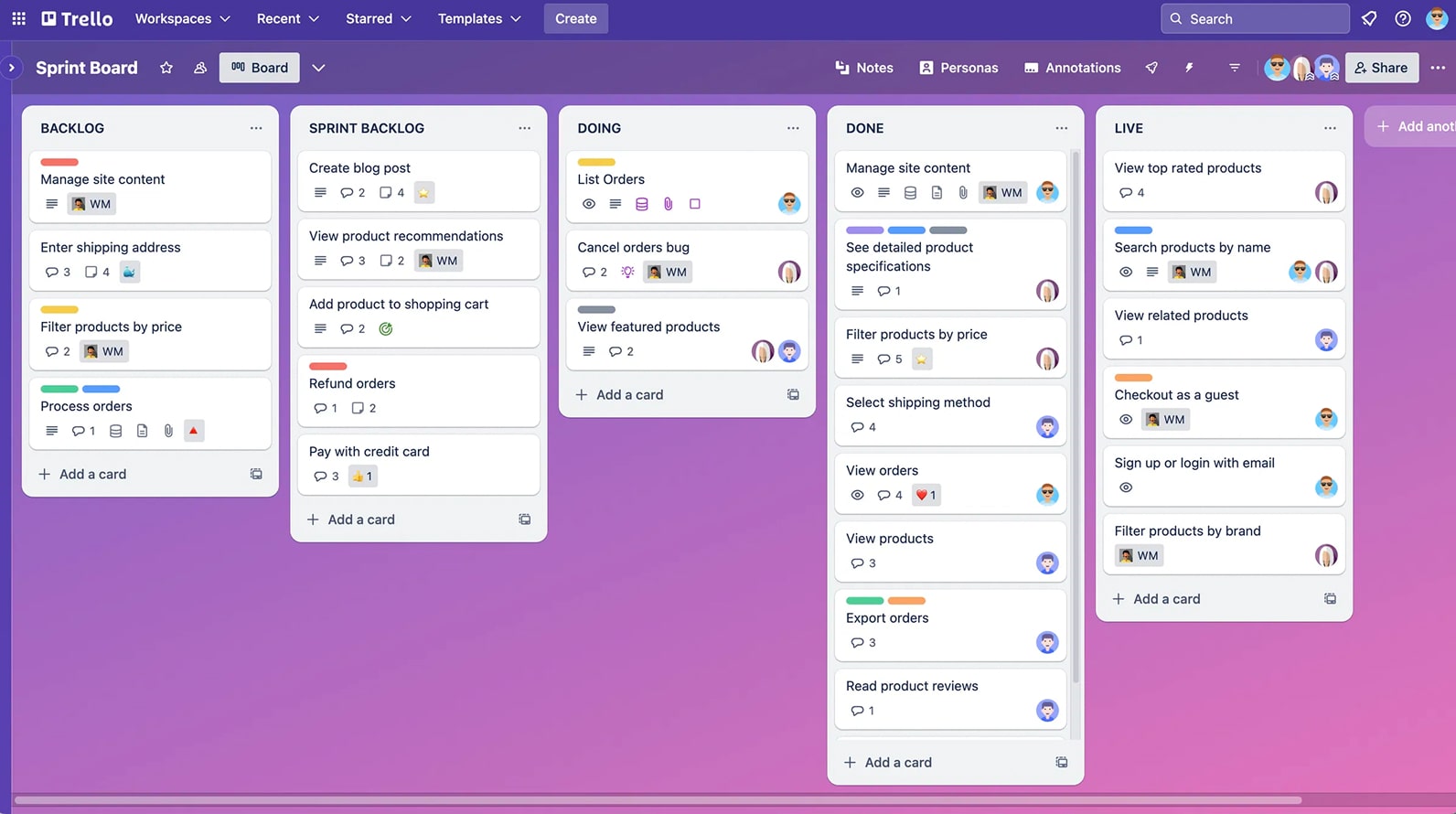
GitHub Issues
GitHub Issues integrates bug tracking directly into code repositories, streamlining workflows for developers. With 100 million users on GitHub (2023), it’s a lightweight, developer-centric option that ties bugs to code commits effortlessly.
Pricing: Free with GitHub’s free tier (public/private repos); paid plans like GitHub Team at $4 per user/month or Enterprise at $21 per user/month add advanced features and private repo support.
GitHub Issues key features:
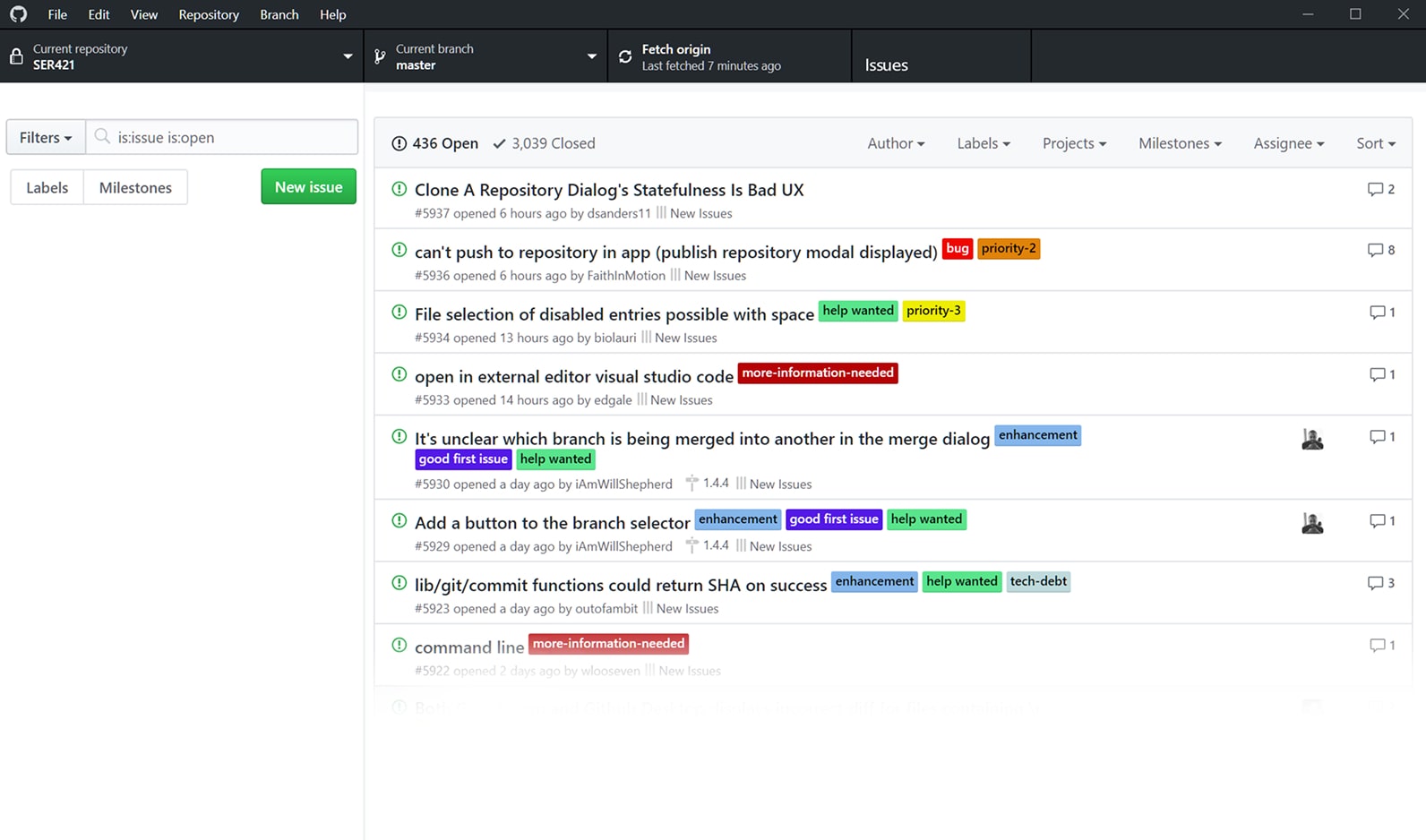
What other bug and issue management resources do you need to have?
Bug-tracking software is the backbone of defect management, but it’s not the whole story.
Beyond the software itself, a robust QA strategy hinges on additional resources that amplify efficiency, clarity, and results. Here’s what else you need to master bug and issue management:
Comprehensive documentation
Resources like Atlassian’s Jira documentation or GitHub’s issue tracking guides provide templates and examples that streamline bug reporting.
TechSmith survey found that teams with well-maintained documentation resolve issues 40% faster than those without. Whether it’s a wiki, a shared drive, or a knowledge base, clear documentation ensures everyone – from testers to devs – knows the game plan, reducing missteps and accelerating fixes.
Collaboration platforms
Real-time chatter keeps QA dynamic and responsive - QA engineer checks a glitch in JIRA, shares a screenshot in Slack, and the dev jumps in – fixed in hours, not days. No wonder that Slack study showed integrated collaboration cuts project delays by 27%.
CI/CD pipelines
A 2023 DevOps Institute survey found 72% of teams with CI/CD pipelines report fewer production defects. Jenkins, GitLab CI, or CircleCI – automate testing and deployment, nabbing bugs before they fester. It's a proactive strategy that keeps development humming and bug lists lean.
Code review tools
Regular code reviews catch 60% of defects before they reach production and help 74% of developers feel more confident in their work. Tools like Crucible, Gerrit, or GitHub’s pull requests (PRs) let developers submit code changes for scrutiny. Peers analyze the diff, leave comments, and approve or flag issues – all before merging into the main branch. Automation helps too – tools like CodeClimate or SonarQube can pre-scan for syntax errors, letting humans tackle the tricky stuff. Tie this to your bug tracker, and you’ve got a system where prevention meets resolution.
Conclusion
Bug tracking software isn’t just a tool – it’s a catalyst for excellence. Bug tracking tools save time and money – fixing a bug during testing costs 5x less than post-release, per NIST – while boosting accountability and communication, with tools like Jira driving a 30% collaboration efficiency gain.
The list of the best bug tracking tools include:
By catching issues early, these tools slash development expenses and prevent costly rework. Accountability also sharpens, with tools like Redmine driving a 25% improvement in project completion rates by assigning ownership and tracking progress.
Obviously, effective quality assurance extends beyond just bug tracking software. Even with the best-in-class available QA engineers for hire, support of complementary resources like detailed documentation (e.g., Jira guides), team training, integrations with CI/CD pipelines (e.g., GitHub Issues with Jenkins), and progress-tracking analytics (e.g., monday dev dashboards) are vital.
These elements work in tandem with bug trackers to create a robust, well-rounded QA ecosystem that ensures consistent, high-quality outcomes.
Ready to take your QA to the next level? Take the first step toward bug-free brilliance and contact DeviQA today for expert QA guidance and support tailored to your needs.
Team up with an award-winning software QA and testing company
Trusted by 300+ clients worldwide
Similar Posts

5 minutes to read
Top 7 AB Testing Tools That You Should Use in 2025
- Mobile App Testing Tools
- Android App Testing Tools
- Mobile App Automation Testing Tools
- App Testing Tools
- iOS App Testing Tools

11 minutes to read
Best Cross Browser Testing Tools in 2025
- Cross Browser Tools
- Cross Browser Testing
- Tools for Testing Browser
- Cross Browser ToolsReview

26 minutes to read
Top automation testing tools of 2025
- Software Test Automation
- Automated Testing
